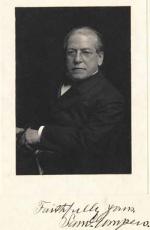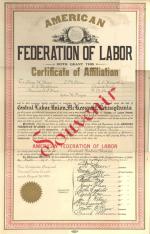![header=[Marker Text] body=[On Nov. 15, 1881, in nearby Turner Hall, a convention was held to form the organization which became the American Federation of Labor. Soon it was the nation's largest labor federation. It became part of the merged AFL-CIO in 1955.] sign](http://explorepahistory.com/kora/files/1/10/1-A-23F-139-ExplorePAHistory-a0h6u9-a_450.jpg)
Mouse over for marker text
Name:
Founding Convention of the AFL
Region:
Pittsburgh Region
County:
Allegheny
Marker Location:
Mellon Center between 5th and 6th Sts., Pittsburgh
Dedication Date:
September 24, 1997
Behind the Marker
"Industrial development is generally reflected in labor organizations," observed Samuel Gompers, president for many years of the American Federation of Labor.
Since colonial times, skilled craft workers had dominated American industry, and the American labor movement had been organized along craft lines. For decades craft unions of skilled printers, bricklayers, carpenters, and ironworkers, among others, controlled their respective trades by training new members and bargaining with employers.
In the 1880s, mass production methods were beginning to sweep across American industry while eroding many skilled trades. It would take many decades, however, for the American labor movement to successfully form unions in steel and the other new mass production industries.
In November of 1881, 107 delegates representing a variety of local, city, regional, and national union organizations met at Turner Hall in Pittsburgh to organize a new Federation of Organized Trades and Labor Unions (FOTLU). There were cigar makers and coopers, granite cutters and printers, iron and steel workers, cotton and wool spinners, lake seamen, and German printers. Gompers, the leading figure in craft unionism for nearly half a century, was a cigar maker. Skilled craft workers soundly dominated FOTLU - and the mainstream of American organized labor - especially after the
Pittsburgh to organize a new Federation of Organized Trades and Labor Unions (FOTLU). There were cigar makers and coopers, granite cutters and printers, iron and steel workers, cotton and wool spinners, lake seamen, and German printers. Gompers, the leading figure in craft unionism for nearly half a century, was a cigar maker. Skilled craft workers soundly dominated FOTLU - and the mainstream of American organized labor - especially after the  Knights of Labor went its own way.
Knights of Labor went its own way.
Sharply critical of Gompers' exclusive focus on skilled workers, the Knights of Labor wanted "one big union" open to skilled and unskilled workers alike. In 1886 the Knights called for a national strike for an eight-hour workday but this effort tragically exploded into violence. At a peaceful labor rally in Haymarket Square in Chicago, a bomb allegedly planted by anarchists wreaked havoc. The Knights never recovered from the adverse publicity and the resulting repression.
In the aftermath of Haymarket, Samuel Gompers convened a conference of trade unions at Columbus, Ohio. There, the FOTLU dissolved itself, and merged with twelve other national unions, various trade assemblies and local unions, to form the American Federation of Labor with a total of 140,000 members. Gompers led the AFL to become the nation's most powerful and prominent union. But the AFL strategy for success was to focus on skilled, white male workers - the loss of whose labor might cripple their employers - and to distance the union from women, African Americans, unskilled laborers, and others who might undermine public sympathy for the craft union cause.
The AFL had surprisingly little to do with steel workers. The Amalgamated Association of Iron and Steel Workers, formed in 1876, comprised skilled iron puddlers and skilled rolling mill workers. Even though the Amalgamated was formally an AFL union it got little support from Gompers' organization. Neither the AFL nor the Amalgamated showed any interest in organizing the unskilled laborers or semiskilled operatives who increasingly filled up the steel mills. In the great labor wars that followed, employers, backed by state and local government and the courts, employed a diverse arsenal of weapons to impose and maintain their control over the mill towns and labor force.
During these "lean years," workers found themselves largely powerless against the onslaught of court injunctions, private police forces, company spies and company controlled unions, as well as the firing and blacklisting of "agitators," the flagrant manipulation of the news media, and the frequent use of non-union immigrants and African as strikebreakers.
Crippled in the Homestead strike of 1892, the Amalgamated was finished off by unsuccessful strikes in 1901 and 1909. The AFL pointedly sat out the 1901 steel strike, despite a plea from the Amalgamated for support. In the violent
Homestead strike of 1892, the Amalgamated was finished off by unsuccessful strikes in 1901 and 1909. The AFL pointedly sat out the 1901 steel strike, despite a plea from the Amalgamated for support. In the violent  McKees Rocks of 1909, the Amalgamated was hardly a factor, as the mass of immigrant workers turned to the radical Industrial Workers of the World. In the great
McKees Rocks of 1909, the Amalgamated was hardly a factor, as the mass of immigrant workers turned to the radical Industrial Workers of the World. In the great  steel strike of 1919 the AFL endorsed the organizing effort, but its unwieldy craft union structure and meager financial support inhibited the organizational work of experienced organizers like William Z. Foster, John Fitzpatrick, and
steel strike of 1919 the AFL endorsed the organizing effort, but its unwieldy craft union structure and meager financial support inhibited the organizational work of experienced organizers like William Z. Foster, John Fitzpatrick, and  Mother Jones.
Mother Jones.
 Attorney General A. Mitchell Palmer, chief architect of the ensuing Red Scare that jailed many left-wing labor activists, called the failure of the steel strike "a complete victory for the American Federation of Labor." Palmer, like many political leaders of the time, believed Gompers' cautious unionism would stave off more fundamental change in industry.
Attorney General A. Mitchell Palmer, chief architect of the ensuing Red Scare that jailed many left-wing labor activists, called the failure of the steel strike "a complete victory for the American Federation of Labor." Palmer, like many political leaders of the time, believed Gompers' cautious unionism would stave off more fundamental change in industry.
Not until their affiliation with the Congress of Industrial Organizations, and participation in the
Congress of Industrial Organizations, and participation in the  Steel Workers Organizing Committee during the depths of the Great Depression, were Pennsylvania's steel workers finally able to unionize. And it would be another two decades, before the Pennsylvania and American craft and industrial unionists came together, in 1955, in the merged AFL-CIO.
Steel Workers Organizing Committee during the depths of the Great Depression, were Pennsylvania's steel workers finally able to unionize. And it would be another two decades, before the Pennsylvania and American craft and industrial unionists came together, in 1955, in the merged AFL-CIO.
Since colonial times, skilled craft workers had dominated American industry, and the American labor movement had been organized along craft lines. For decades craft unions of skilled printers, bricklayers, carpenters, and ironworkers, among others, controlled their respective trades by training new members and bargaining with employers.
In the 1880s, mass production methods were beginning to sweep across American industry while eroding many skilled trades. It would take many decades, however, for the American labor movement to successfully form unions in steel and the other new mass production industries.
In November of 1881, 107 delegates representing a variety of local, city, regional, and national union organizations met at Turner Hall in
Sharply critical of Gompers' exclusive focus on skilled workers, the Knights of Labor wanted "one big union" open to skilled and unskilled workers alike. In 1886 the Knights called for a national strike for an eight-hour workday but this effort tragically exploded into violence. At a peaceful labor rally in Haymarket Square in Chicago, a bomb allegedly planted by anarchists wreaked havoc. The Knights never recovered from the adverse publicity and the resulting repression.
In the aftermath of Haymarket, Samuel Gompers convened a conference of trade unions at Columbus, Ohio. There, the FOTLU dissolved itself, and merged with twelve other national unions, various trade assemblies and local unions, to form the American Federation of Labor with a total of 140,000 members. Gompers led the AFL to become the nation's most powerful and prominent union. But the AFL strategy for success was to focus on skilled, white male workers - the loss of whose labor might cripple their employers - and to distance the union from women, African Americans, unskilled laborers, and others who might undermine public sympathy for the craft union cause.
The AFL had surprisingly little to do with steel workers. The Amalgamated Association of Iron and Steel Workers, formed in 1876, comprised skilled iron puddlers and skilled rolling mill workers. Even though the Amalgamated was formally an AFL union it got little support from Gompers' organization. Neither the AFL nor the Amalgamated showed any interest in organizing the unskilled laborers or semiskilled operatives who increasingly filled up the steel mills. In the great labor wars that followed, employers, backed by state and local government and the courts, employed a diverse arsenal of weapons to impose and maintain their control over the mill towns and labor force.
During these "lean years," workers found themselves largely powerless against the onslaught of court injunctions, private police forces, company spies and company controlled unions, as well as the firing and blacklisting of "agitators," the flagrant manipulation of the news media, and the frequent use of non-union immigrants and African as strikebreakers.
Crippled in the
Not until their affiliation with the









